Le Mans' thrilling future: behind the wheel of revolutionary MissionH24 hydrogen car
When the Automobile Club de l’Ouest announced a new hydrogen class for the Le Mans 24 Hours starting from 2025, a joint ACO and Green GT programme promptly began – but can the prototype’s tech compete on track? Pascal Dro takes the wheel of the MissionH24

MissionH24
Amid the excitement about electric power, hybrid tech and synthetic fuels, the technology that was once seen as the future seems to have been forgotten. That’s something that a ground-breaking racing project hopes to change. Despite attracting relatively little attention over the past four years since its inception, the hydrogen fuel cell-powered GreenGT/MissionH24 team could well be the most revolutionary thing to appear at Le Mans for a generation.
The project has been developed by the Automobile Club de l’Ouest (ACO) and GreenGT – an independent company specialising in electric-hydrogen technologies to prepare for the arrival of a new Le Mans category reserved for electric and hydrogen-powered cars. This is slated for 2025 and the ACO hopes it will herald a new chapter in the endurance classic. In fact Pierre Fillon, the ACO president and driving force behind the new category, has stated that he hopes to see a hydrogen-powered car fight for the overall win by the end of the decade.
We are not there yet: the current MissionH24 prototype is the third generation of car the company has come up with. The team behind it hope that it will line up on the grid in 2025 and it is currently undergoing a series of tests at the hands of GP2 racers and endurance stars Norman Nato and Stéphane Richelmi. However in a sign of how confident they are, they have allowed Motor Sport to get behind the wheel. It is the first time that GreenGT has agreed to trust its car to a driver with no previous involvement in the programme
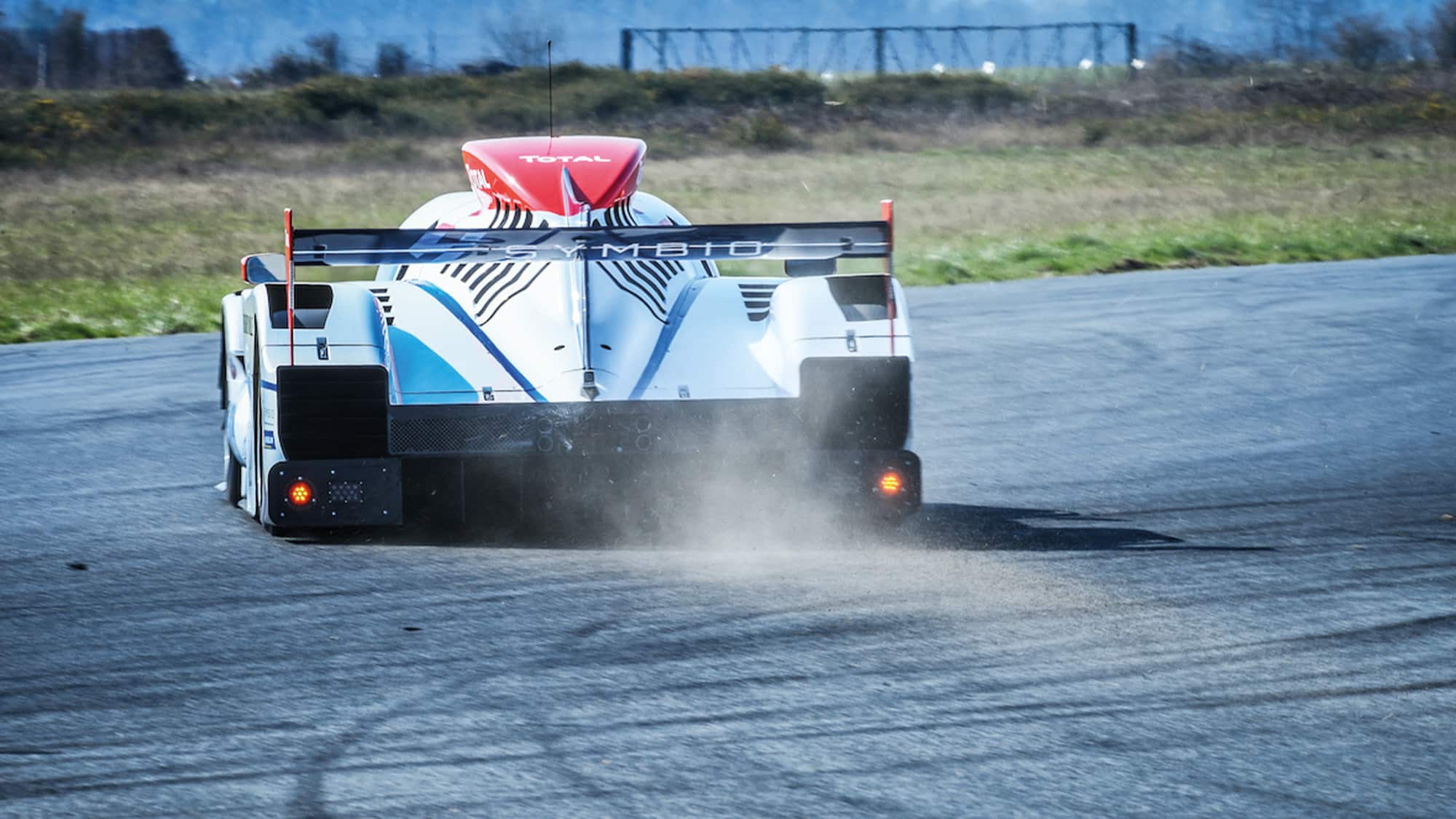
The car retains the classic sports-Prototype stance and quite a few other signature details, but then it derives from an LMP3 chassis that has been modified to accommodate a fuel cell and all the other ancillaries this new technology demands. To begin with, the radiators are large and have little in common with those on Prototypes with conventional internal combustion; the chemical reaction between hydrogen and oxygen produces energy, water and lots of heat.
It’s easy to imagine that in a future iteration of the MissionH24 project this heat will likewise be converted into energy, but we’re not there yet…
“The most prominent sound in the twisty sections is the excessive tyre squeal”
It has been running regularly for more than a year and incorporates thousands of hours of research and testing, exotic materials and countless sleepless nights thinking about answers to fresh questions as they arise following various tests, and as performance increases in tandem with the sophistication of its various systems.
And while fuel-cell technology might have existed for more than a century, its adaptation for road cars is relatively recent – and that for motor racing applications even more so. That is very obvious as soon as you see the car with its engine cover removed – and more so still when you climb behind the wheel.
In the first instance, your eye is caught by two high-mounted, triangular radiators set back from the cockpit and additional to those mounted in the sidepods. It’s like nothing else you’ve ever seen on a racing car. It’s worth noting that the heat generated by the engine’s chemical reactivity is so high that for the time being it is a limiting factor in both the amount of time the car can stay out on track and also in terms of absolute performance.
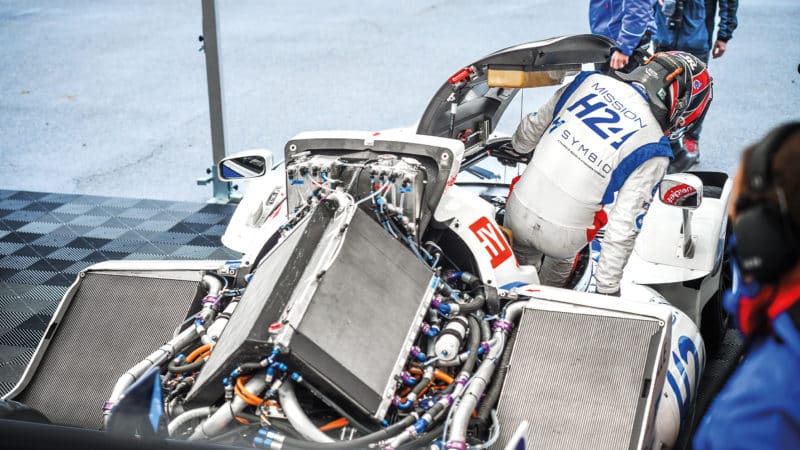
With its engine cover removed, the first thing you notice are the triangular radiators
When you sit behind the wheel, with a full tank of hydrogen at 350 bars of pressure behind you and a bank of green lights illuminated on a panel to the driver’s left to indicate the readiness of various systems, you can’t escape the impression that you are about to learn the art of driving all over again.
When you sit in an LMP2 or LMP3 car with a conventional engine, there is a terrible racket as you wait for everything to warm up. Here, you are not immersed in silence but are surrounded by a strange mixture of burbling from the car’s plumbing. It is strangely redolent of the DeLorean DMC-12 used by Doc and Marty in Back to the Future. It gurgles, it drips and says “pssshhh” while you wait for the battery to warm up, having itself been stirred into life by a modest 12-volt battery. After that, you have to await pre-heating of the 800-volt ‘buffer’ battery and pressurisation of the cooling system. It is only then that the battery comes to life and kick-starts several chemical reaction cycles that last 30 to 40 seconds.
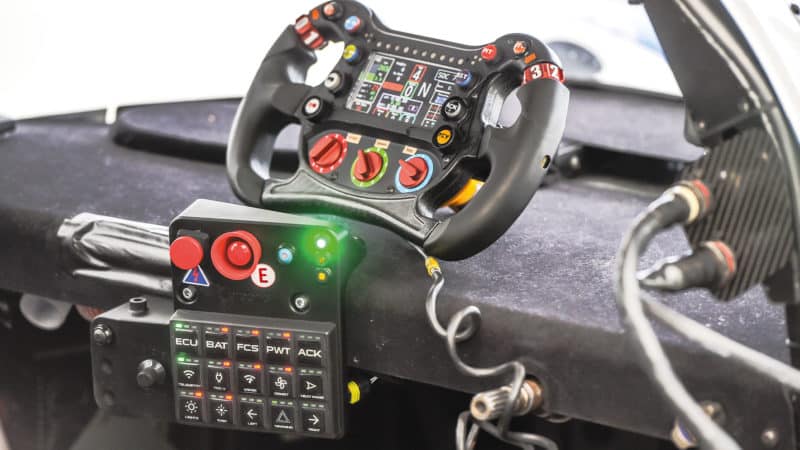
The electric-hydrogen racing prototype is now in its third generation – and getting quicker
Once all the lights have turned green, you can pull away. Pull away? That, too, is a bit different, although the protocol could hardly be simpler: left foot on the brake, right on the throttle, then press and the car takes off without the slightest hitch. There is neither a clutch nor a gearbox.
The car tips the scales at slightly more than 1300kg – about 400kg heavier than a conventional equivalent racing car. A few of its handling traits were unexpected, for it retains some of the agility of an LMP2 or LMP3 car, as well as an incredible capacity for roll-free directional changes and the ability to absorb lateral loads, but such things demand a level of attention.
Furthermore, the test was in winter temperatures – barely above zero – at Lurcy-Lévis, central France, and the fat, LMP3-spec Michelin slicks clearly weren’t designed for such conditions.
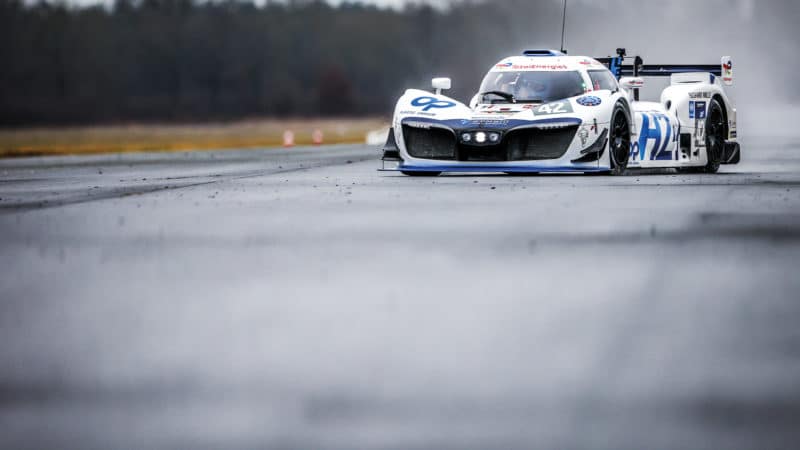
The Mission 24 hydrogen prototype
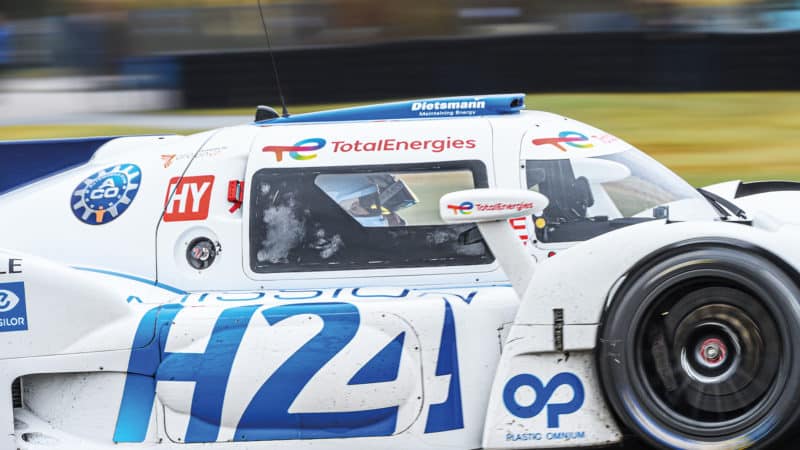
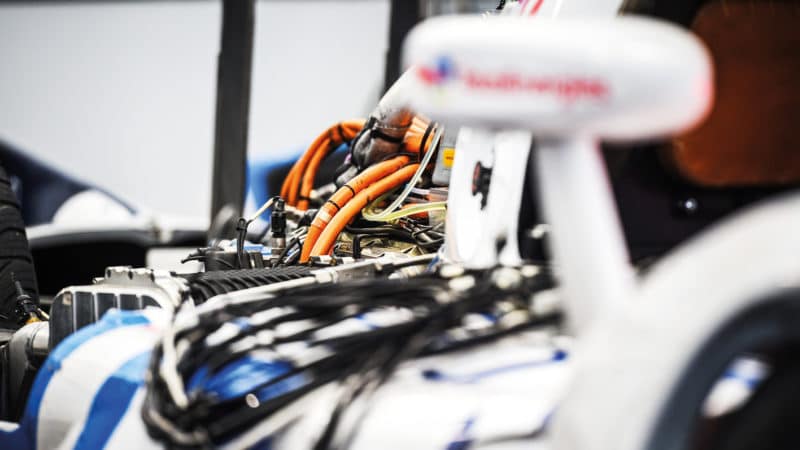
Before handing me the wheel, Stéphane Richelmi spent two laps trying to explain how everything worked – but only parts of that sunk in fully. On the straights he chose to weave in a bid to build up a bit of tyre temperature, or at least to make sure we didn’t lose any. The Michelins thus had perhaps a bit of temperature in them, the brakes not so much. A car like this will be worth a few million euros, so once installed behind the wheel there was absolutely no question of taking any risks. That said, with traction control turned up to the max and power voluntarily capped, the likelihood of sliding was fairly small – despite which I still felt slightly nervous.
The first surprise was that Stéphane and I were able to communicate directly, chatting from within our helmets – something that never usually happens in a racing car, or even in a performance GT at speed. But once on the move, the cockpit is no noisier than it is at standstill. The reactive chemical burbling carries on continuously without either acceleration or reduced energy demands affecting the sound it makes.
In this test configuration, Stéphane estimates that the battery generates about 250kW (350bhp) and the fuel cell 220kW (295bhp). “I don’t know whether you can feel it,” he says, “but the feeling through the pedal is not the same in fuel-cell mode as it is when you have power from the fuel cell and battery together. It’s a bit odd, sure, but you quickly forget all about it.”
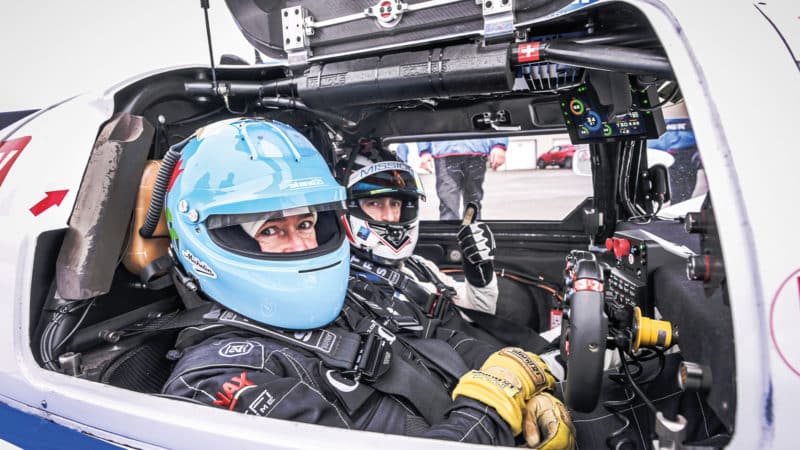
Test driver Stéphane Richelmi gives some tips before our solo drive
The multiple warning lights looked familiar – unsurprising, as they come from a Cosworth LMP2 dash, but in this instance I hadn’t yet had the chance to grasp what they all meant. Of greater concern, perhaps, was the team’s ability to adjust and monitor the car remotely – so any mistakes I made would be fully visible. But that was soon forgotten thanks to the car’s ability to inspire confidence very quickly – not least because it was so easy to drive. Accelerate hard along the first straight and, even with your foot to the floor, the car pulls fiercely without wandering at all.
Braking required a bit more effort simply because nothing was up to temperature. It’s imperative to anticipate, then hit the brakes to build up some temperature before turning in early – much more like a heavy GT car than an LMP1 prototype or a single-seater. There’s quite a bit of lock, you turn in on the brakes and then hit the throttle progressively, but as quickly as possible, to build up speed for the following straight. I would say ‘to increase revs’, but it’s another traditional reference point that disappears because you are no longer really aware of what the engine is doing. Similarly, but stranger still, the most prominent sound in the twisty sections is the excessive tyre squeal, though at least that tells you when they are about to start sliding.
With these initial sensations having been taken on board, it soon feels comfortable to push harder. When you accelerate the car obeys and you don’t have much more to do other than keep an eye on the braking point and apex for the next corner. There is no noise, no need to downchange, nothing to disrupt your focus. It really is that simple. And when you reach a sequence of tight bends it’s even easier, because all you do is concentrate on your line and the appropriate cornering speed. It’s here, though, that you become most aware of the engine’s weight and how it compromises low-speed agility.
The two-seater version lapped Spa in 2min 33sec in 2019. Weighing 200kg less, the second H24 recorded 2min 27sec a year later; a conventional LMP3, from which the chassis is borrowed, laps around 2min 15sec, so the performance gap is not enormous. Richelmi is convinced by its potential: “I think we could find two seconds per lap simply through chassis set-up changes,” he says. “And by optimising everything we have on the car right now, we could probably find another two to three.”
That confirms that this hydrogen racing project is at a key moment in its short history, where its performance starts to become realistic. The other question concerns its reliability. Richelmi has no doubts. “We completed a series of 12 laps at Portimão at a decent pace,” he says. “That doesn’t yet equate to a 45-minute stint at Le Mans, but it was a serious run and we cut it short only because the systems began to overheat. We have since done work in that area, but appreciate that a bit more still lies ahead.”
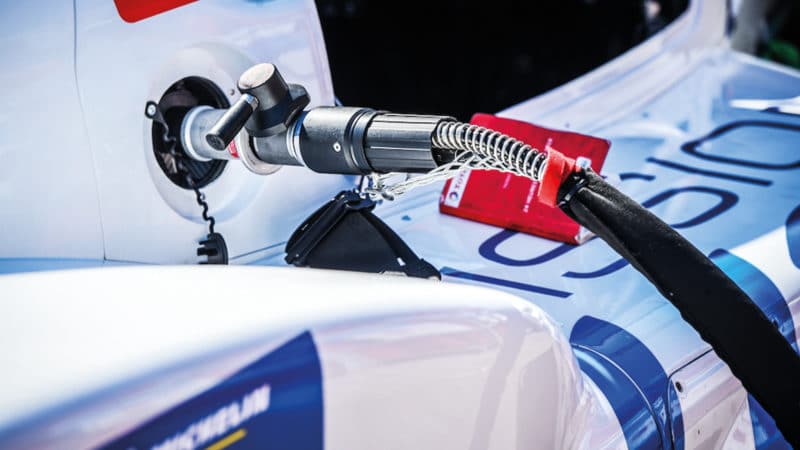
A k of hydrogen at 0 bars of pressure… hen you hear burbling from inside the car
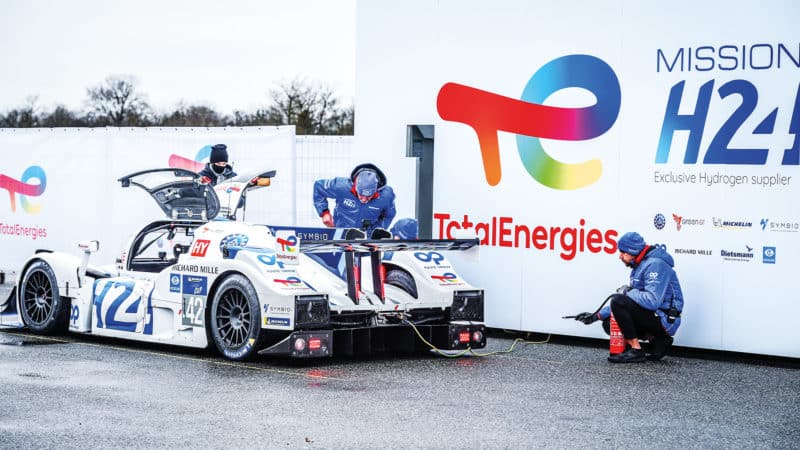
No exhaust fumes for the MissionH24 crew – just water vapour
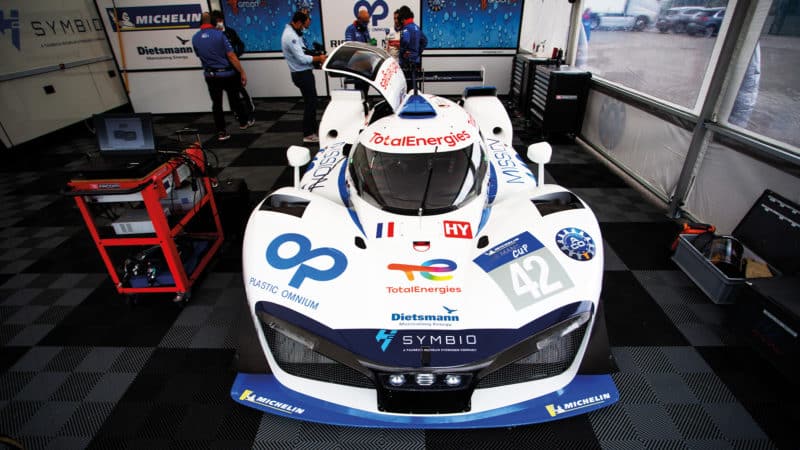
The prototype was a visitor at the qualifying sessions at Le Mans in 2021, giving demonstrations
Returning to the pits, I tell myself the test has been too short. And while this might be a prototype for the seasons ahead, it is already simple to learn and opens up fresh possibilities for gentlemen or amateurs who have come to the sport late, those drivers who might struggle to get on the pace in a conventional racer with gearbox and greater handling complexities at the limit. In this case, all the genes of a quick, simple, ethical, attractive and exciting racing car are present. It was a thrilling ride and there is the distinct impression of having just taken a step into our sport’s future.
After we finish, a crowd gathers and we are bombarded with questions. It’s as if we have just returned to Earth from a Moon landing. Nevertheless, this machine forms the basis of future competition racing and will surely play its part in the evolution of cars we’ll drive every day. As I get out, I’m offered a bottle of water that has been produced by the car while it was on the circuit.
Everybody wants to know how it performs and there is no doubting the level of interest in hydrogen as a potential fuel of the future. Sceptics should be aware that this is a thoroughbred racing car, evolving right now in front of our eyes. It is fully operational, ripe with promise and carries many hopes that could soon become reality. This is a very real revolution.
